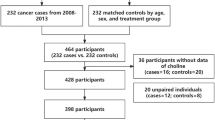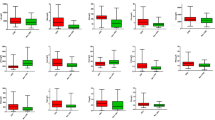Abstract
Objective: To study the predictive power of serum selenium with regard to cancer mortality in a large sample of the Belgian population given the lack of coherence in the results of observational epidemiological studies in this domain.
Design: A prospective case–control study within a stratified sample of the Belgian male and female population.
Subjects: A total of 201 cases randomly selected from all cancer deaths (N=343) during a 10-y mortality follow-up of a large age- and sex-stratified sample of the total Belgian population aged 25–74 y were matched for age and gender with 603 controls.
Statistics: Conditional logistic regression for both univariate and multivariate analyses using tertile distribution of serum selenium in controls. Odds ratios (ORs) are adjusted for 10 baseline characteristics.
Results: Unadjusted ORs of cancer deaths taking the highest tertile of serum selenium as a reference: in male subjects T1/T3 is 2.2 (CI 1.3–3.7) (P for trend 0.011), whereas in female subjects a nonsignificant OR of 0.8 is observed. In multivariate analyses, no significant modifications of the ORs are observed for the predictive relation of serum selenium with cancer mortality. Besides serum selenium, beta-carotene intake and smoking are independent predictors in male subjects.
Conclusions: In this nested case–control study of a stratified sample from the Belgian population, serum selenium is an independent predictor of cancer mortality in male subjects only, in a country with rather high serum selenium levels with respect to most other European countries.
This is a preview of subscription content, access via your institution
Access options
Subscribe to this journal
Receive 12 print issues and online access
$259.00 per year
only $21.58 per issue
Buy this article
- Purchase on Springer Link
- Instant access to full article PDF
Prices may be subject to local taxes which are calculated during checkout
Similar content being viewed by others
References
Alfthan G & Nève J (1996): Reference values for serum selenium in various areas evaluated according to the TRACY protocol. J. Trace Elements Med. Biol. 10, 77–87.
Blot WJ, Li J-Y, Taylor PR, Guo W, Dawsey S, Wang G-Q, Yang CS, Zheng S-F, Gail M, Li G-Y, Yu Y, Liu B-q, Tangrea J, Sun Y-h, Liu F, Fraumeni JF, Zhang Y-H & Li B (1993): Nutrition intervention trials in Linxian, China: supplementation with specific vitamin/mineral combinations, cancer incidence, and disease-specific mortality in the general population. J Natl Cancer Inst. 85, 1483–1492.
Breslow N & Day W (1980): Statistical models in cancer research. In The Analysis in Case–Control Studies Vol 1. Lyon: IARC scientific publication. No 32, IARC Editors.
Breslow NE, Day NE, Halvorsen KT, Prentice RL & Sabai C (1978): Estimation of multiple risk functions in matched case-control studies. Am. J. Epidemiol. 108, 229–307.
Clark LC, Cantor KP & Allaway WH (1991): Selenium in forage crops and cancer mortality in US counties. Arch. Environ. Health 46, 37–42.
Clark LC, Combs GF, Turnbull BW, Slate EH, Chalker DK, Chow J, Davis LS, Glover RA, Graham GF, Gross EG, Krongrad A, Lesher JL, Park HK, Sanders BB, Smith CL, Taylor JR for the Nutritional Prevention of Cancer Study Group (1996): Effects of selenium supplementation for cancer prevention patients with carcinoma of the skin: a randomised controlled trial. JAMA 276, 1957–1963.
Coates RJ, Weiss NS, Daling JR et al (1988): Serum levels of selenium and retinol and the subsequent risk of cancer. Am. J. Epidemiol. 128, 515–523.
Combs GF & Gray WP (1998): Chemopreventive agents: selenium. Pharmacol. Ther. 79, 179–192.
Comstock GW, Bush TL & Helzlsouer K (1992): Serum retinol, beta-carotene, vitamin E, and selenium as related to subsequent cancer of specific sites. Am. J. Epidemiol. 135, 115–121.
Fex G, Pettersson GFB & Akesson B (1987): Low plasma selenium as a risk factor for cancer death in middle-aged men. Nutr. Cancer 10, 221–229.
Garland M, Morris JS, Bosner BA et al (1993): Toenail trace element levels as biomarked: reproducibility over a 6-year period. Cancer Epidemiol. Biomarkers Prev. 2, 493–497.
Garland M, Morris JS, Stampfer MJ, Colditz GA, Spate VL, Baskett CK, Rosner B, Speizer FE, Willett WC & Hunter DJ (1995): Prospective study of toenail selenium levels and cancer among women. J. Natl. Cancer Inst. 87, 497–505.
Glattre E, Thomassen Y, Thoresen SO, Haldorsen T, Lung-Larsen PG, Theodorsen L & Aaseth J (1989): Prediagnostic serum selenium in a case–control study of thyroid cancer. Int. J. Epidemiol. 18, 45–49.
Hartman TJ, Albanes D, Pietinen P, Hartman AM, Rautalahti M, Tangrea J & Taylor P (1998): The association between baseline vitamin E, selenium, and prostate cancer in the alpha-tocopherol, beta-carotene cancer prevention study. Cancer Epidemiol. Biomarkers Prev. 7, 335–340.
Helzlsouer KJ, Alberg AJ, Norkus EP, Morris JS, Hoffman SC & Comstock GW (1996): Prospective study of serum micronutrients and ovarian cancer. J. Natl. Cancer Inst. 88, 32–37.
Helzlsouer KJ, Comstock GW & Morris S (1989): Selenium, lycopene, α-tocopherol, β-carotene, retinol, and subsequent bladder cancer. Cancer Res. 49, 6144–6148.
Hercberg S, Galan P, Preziosi P et al (1998): Background and rationale behind the SU.VI.MAX study, a prevention trial using nutritional doses of a combination of antioxidant vitamins and minerals to reduce cardiovascular diseases and cancers. Int. J. Vit. Nutr. Res. 68, 3–20.
Hunter DJ, Morris JS, Stampfer MJ, Colditz GA, Speizer FE & Willett WC (1990): A prospective study of selenium status and breast cancer risk. JAMA 264, 1128–1131.
Ip C (1986): Selenium and experimental cancer. Ann. Clin. Res. 18, 22–29.
Klein E, Thompson I, Lippman S, Goodman P, Albanes D, Taylor P, Coltman C (2001): SELECT: the next prostate cancer prevention trial. J. Urol. 166, 1311–1315.
Knekt P, Aromaa A, Maatela J, Alfthan G, Aaran R-K, Teppo L & Hakama M (1988): Serum vitamin E, serum selenium and the risk of gastrointestinal cancer. Int. J. Cancer 42, 846–850.
Knekt P, Aromaa A, Maatela J, Alfthan G, Aaran R-K, Hakama M, Hakulinen T, Peto R & Teppo L (1990): Serum selenium and subsequent risk of cancer among Finnish men and women. J. Natl. Cancer Inst. 82, 864–868.
Knekt P, Marniemi J, Teppo L, Heliövaara M & Aromaa A (1998): Is low selenium status a risk factor for lung cancer?. Am. J. Epidemiol. 148, 975–982.
Kok JF, deBruijn M, Hofman A, Vermeeren R & Valkenburg HA (1987): Is serum selenium a risk factor for cancer in men only? Am. J. Epidemiol. 125, 12–16.
Marshall JR (2001): Larry Clark's legacy: randomised controlled, selenium-based prostate cancer chemoprevention trials. Nutr. Cancer 40, 74–77.
Menkes MS, Comstock GW, Vulleumier JP, Helsing KJ, Rider AA & Brookmeyer R (1986): Serum beta-carotene, vitamins A and E, selenium, and the risk of lung cancer. New Engl. J. Med. 315, 1250–1254.
Nève J (2000): New approaches to assess selenium status and requirement. Nutr. Rev. 58, 363–369.
Nève J, Chamart S & Molle L (1987): Optimization of a direct procedure for the determination of selenium in plasma an erythrocytes using zeeman effect atomic absorption spectroscopy. In Trace Element — Analytical Chemistry in Medicine and Biology, Vol 4, eds P Brätter & P Schramel. Berlin, New York: Walter de Gruyter & Co.
Nomura A, Heilbrun LK, Morris JS & Stemmermann GN (1987): Serum selenium and the risk of cancer, by specific sites: case–control analysis of prospective data. J. Natl. Cancer Inst. 79, 103–108.
Nomura MJ (ed) (1990): SPSS Statistical Data Analysis. Chicago: SPSS Inc.
Nutrition and health: an interuniversity study (1984): Regional differences in dietary habits, coronary risk factors and mortality rates in Belgium. I. Design and methodology. Acta Cardiol. 39, 285–292.
Paul AA & Southgate DAT (1980): The Composition of Foods, 4th revised and extended edition. MRC Report No. 297, London.
Raich PJ, Lü J, Thompson H & Combs G (2001): Selenium in cancer prevention: clinical issues and implications. Cancer Invest. 19, 540–553.
Rayman MP (2000): The importance of selenium to human health. Lancet 356, 233–241.
Ringstad J, Jacobsen BK, Tretli S & Thomassen Y (1988): Serum selenium concentration associated with risk of cancer. J. Clin. Pathol. 41, 454–457.
Salonen JT, Alfthan G, Huttunen JK & Puska P (1984): Association between serum selenium and the risk of cancer. Am. J. Epidemiol. 120, 342–349.
Salonen JT, Salonen R, Lappeteläinen R, Maenpaa P, Alfthan G & Puska P (1985): Risk of cancer in relation to serum concentrations of selenium and vitamins A and E: matched case–control analysis of prospective data. BMJ 290, 417–420.
Schrober SE, Comstock GW, Helsing KJ, Salkeld RM, Morris JS, Rider AA & Brookmeyer R (1987): Serologic precursors of cancer. Prediagnostic serum nutrients and colon cancer risk. Am. J. Epidemiol. 126, 1033–1041.
Van den Brandt PA, Goldbohm RA, van't Veer P, Bode P, Dorant E, Hermus RJJ & Sturmans F (1993a): A prospective cohort study on selenium status an the risk of lung cancer. Cancer Res. 53, 4860–4865.
Van den Brandt PA, Goldbohm RA, van't Veer P, Bode P, Dorant E, Hermus RJJ & Sturmans F (1993b): A prospective cohort study on toenail selenium levels and risk of gastrointestinal cancer. J. Natl. Cancer Inst. 85, 224–229.
Van Noord PAH, Collette HJA, Maas MJ & De Waard F (1987): Selenium levels in nails of premenopausal breast cancer patients assessed prediagnostically in a cohort-nested case-referent study among women screened in the DOM project. Int. J. Epidemiol. 16, 318–322.
Varo P, Alfthan G, Ekholm P, Aro A & Koivistoinen P (1988): Selenium intake and serum selenium in Finland: effects of soil fertilization with selenium. Am. J. Clin. Nutr. 48, 324–329.
Vinceti M, Rovesti S, Bergomi M & Vivoli G (2000): The epidemiology of selenium and human cancer. Tumori 86, 105–118.
Virtamo J, Valkeila E, Alfthan G, Punsar S, Huttunen JK & Karvonen MJ (1987): Serum selenium and risk of cancer. A prospective follow-up of nine years. Cancer 60, 145–148.
Willett WC, Polk BF, Morris JS, Stampfer MJ, Pressel S, Rosner B, Taylor JO, Schneider K & Hames CG (1983): Prediagnostic serum selenium and risk of cancer. Lancet 2, 130–134.
World Cancer Research Fund in Association with American Institute for Cancer Research (1997): In Food, Nutrition and the Prevention of Cancer: A Global Perspective, pp 417–458, Washington DC, USA.
Yoshizawa K, Willett WC, Morris SJ, Stampfer MJ, Spiegelman D, Rimm EB & Giovannucci E (1998): Study of prediagnostic selenium level in toenails and the risk of advanced prostate cancer. J. Natl. Cancer Inst. 90, 1219–1224.
Yu SY, Zhu YJ & Li WG (1997): Protective role of selenium against hepatitis B virus and primary liver cancer in Qidong. Biol. Trace Element. Res. 56, 117–124.
Author information
Authors and Affiliations
Corresponding author
Rights and permissions
About this article
Cite this article
Kornitzer, M., Valente, F., De Bacquer, D. et al. Serum selenium and cancer mortality: a nested case–control study within an age- and sex-stratified sample of the Belgian adult population. Eur J Clin Nutr 58, 98–104 (2004). https://doi.org/10.1038/sj.ejcn.1601754
Received:
Revised:
Accepted:
Published:
Issue Date:
DOI: https://doi.org/10.1038/sj.ejcn.1601754
Keywords
This article is cited by
-
Sex difference in the association between plasma selenium and first stroke: a community-based nested case-control study
Biology of Sex Differences (2021)
-
Circulating Selenium and Cardiovascular or All-Cause Mortality in the General Population: a Meta-Analysis
Biological Trace Element Research (2020)
-
Selenium Exposure and Cancer Risk: an Updated Meta-analysis and Meta-regression
Scientific Reports (2016)
-
Selenium is inversely associated with interleukin-6 in the elderly
The journal of nutrition, health & aging (2013)
-
Low serum selenium is associated with anemia among older adults in the United States
European Journal of Clinical Nutrition (2009)



